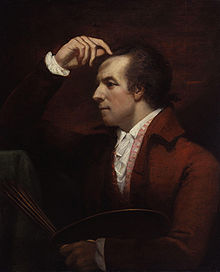James Northcote
James Northcote RA | |
|---|---|
 | |
| Born | James Northcote 22 October 1746 Plymouth, England, Kingdom of Great Britain |
| Died | 13 July 1831 (aged 84) |
| Nationality | English |
James Northcote RA (22 October 1746, in Plymouth – 13 July 1831, in London) was a British painter.[1]
Life and work
Northcote was born in
In 1775 he left Reynolds' studio, and about two years later, having made some money by portrait painting back in Devon, he went to study in Italy. On his return to England, three years later, he revisited his native county, then settled in London, where John Opie and Henry Fuseli were his rivals. He was elected associate of the Academy in 1786, and full academician in the following spring. The Young Princes Murdered in the Tower, his first important work on a historical subject, dates from 1786, and it was followed by the Burial of the Princes in the Tower. Both paintings, along with seven others, were intended for Boydell's Shakespeare Gallery.[1] His enormous Death of Wat Tyler was exhibited in 1787;[1] commissioned by a London alderman, it hung in the Guildhall until its destruction during the Second World War.[2]
Shortly afterwards Northcote began a set of ten subjects, entitled "The Modest Girl and the Wanton", which were completed and engraved in 1796. Among the productions of Northcote's later years are the Entombment and the Agony in the Garden, besides many portraits, and several animal subjects, such as Leopards, Dog and Heron, and Lion; these were more successful than the artist's attempts at more elevated subjects, as was indicated by Fuseli's caustic remark on examining the Angel opposing Balaam —"Northcote, you are an angel at an ass, but an ass at an angel." Northcote's works number about 2000, and he made a fortune of £40,000.


He was elected to the
In 1841 a monument to Northcote by
Writings
Northcote also sought fame as an author, and his first essays were contributions to the Artist, edited by
Notes
- ^ a b c Lee, Sidney, ed. (1895). . Dictionary of National Biography. Vol. 41. London: Smith, Elder & Co. pp. 190–3.
- ISBN 9781136636486.
- ^ "T.J. Northcote (1746–1831)". Royal Netherlands Academy of Arts and Sciences. Retrieved 13 July 2020.
- ^ Dictionary of British Sculptors 1660-1851 by Rupert Gunnis
- ^ Ledbury, Mark . Exhibition catalogue, YCBA.
References
- Mark Ledbury (2014), James Northcote, History Painting, and the Fables, Yale Center for British Art in association with Yale University Press. ISBN 978-0-3002081-3-9
